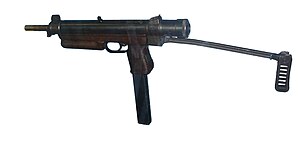Sa 23: Difference between revisions
Undid revision 608372304 by 90.201.14.101 (talk) Rv addition of non-state user; we only list countries, not organisations. |
→External links: external link it site |
||
| Line 85: | Line 85: | ||
==External links== |
==External links== |
||
*[http://world.guns.ru/smg/smg46-e.htm Sa.23/24/25/26 at guns.ru reference website] |
*[http://world.guns.ru/smg/smg46-e.htm Sa.23/24/25/26 at guns.ru reference website] |
||
*[http://www.armimilitari.it/wordpress/3586/savaopal-vz-24/ SA VZ24] |
|||
<!-- link broken [http://www.nasog.net/datasheets/firearms/smg/CZ_Model_25.htm data sheet] --> |
<!-- link broken [http://www.nasog.net/datasheets/firearms/smg/CZ_Model_25.htm data sheet] --> |
||
Revision as of 12:23, 30 July 2014
| CZ Model 25 | |
|---|---|
 | |
| Type | Submachine gun |
| Place of origin | |
| Service history | |
| Used by | See Users |
| Production history | |
| Produced | 1948–1968 |
| Specifications | |
| Mass | 3.27kg empty (folding stock models Sa 25, Sa 26); 3.5kg empty (fixed wood stock models Sa 23, Sa 24) |
| Length | 445mm folding stock model folded (Sa 25, Sa 26); 686mm fixed stock and unfolded folding stock |
| Barrel length | 284mm |
| Cartridge | 7.62×25mm Tokarev 9×19mm Parabellum |
| Action | Blowback |
| Rate of fire | 650 rpm |
| Feed system | 24 or 40 round (9mm Sa 23, Sa 25); 32 round (7.62mm Sa 24, Sa 26) |
| Sights | Iron |
The CZ Model 25 (properly, Sa 25 or Sa vz. 48b/samopal vz. 48b – samopal vzor 48 výsadkový, "submachine gun model year 1948 para") was perhaps the best known of a series of Czechoslovak designed submachine guns introduced in 1948. There were four generally very similar submachine guns in this series: the Sa 23, Sa 24, Sa 25, and Sa 26. The primary designer was Jaroslav Holeček (1923–1977), chief engineer of the Česká zbrojovka Strakonice arms factory.
The Sa 23 series utilize a straightforward blowback action, with no locked breech, and fire from the open bolt position. They also use a progressive trigger for selecting between semi-automatic fire and fully automatic fire. Lightly pulling on the trigger will fire a single shot. Pulling the trigger farther to the rear in a continuous motion will fire fully automatically, until the trigger is released or the magazine is empty.
The Sa 23 series were the first production-model submachine guns with a telescoping bolt, in which the forwards part of the moving bolt extends forwards past the back end of the barrel, wrapping around that barrel. This feature reduces the required length of the submachine gun significantly and allows for better balance and handling. Handling was further improved by using a single vertical handgrip housing the magazine and trigger mechanism, roughly centered along the gun's length. The gun's receiver was machined from a single circular steel tube.
The design of the Sa 23 series submachine guns is most notable in the West for having heavily inspired the slightly later Uzi submachine gun.[1]
Legal Status and Variations
- The Sa 23 (vz. 48a) was the first variant, using a fixed wood stock and firing standard 9×19mm Parabellum (aka 9mm Luger Parabellum) ammunition. Has a straight vertical pistol grip and ammunition magazine. Magazines were issued with 24 and 40 round capacity.
- The Sa 25 (vz. 48b) was the second and perhaps best known variant, using a folding metal stock, still firing 9×19mm Parabellum ammunition. Other than the folding stock, is identical to the Sa 23 and uses the same 24 and 40 round magazines.
The Sa 24 and Sa 26 were introduced after Czechoslovakia joined the Warsaw Pact, and were redesigned to fire 7.62×25mm Tokarev standard Soviet type pistol ammunition.
- The Sa 24 (vz. 48a/52) corresponds to the Sa.23, using a fixed wood stock and firing 7.62×25mm Tokarev ammunition. Can be visually distinguished from Sa.23 as it has a slightly forwards-slanted pistol grip and ammunition magazine, though the main receiver and other components are otherwise visibly identical. It was issued with 32-round magazines.
- The Sa 26 (vz. 48b/52) corresponds to the Sa.25, with a folding metal stock but otherwise identical to the Sa.24, using the same 32-round magazines.
After the Sa 25 was declared obsolete in 1968, many of the 9mm weapons were sold around the nation. The surplus weapons were exported to other communist countries including North Vietnam. A somewhat-modified copy of the 9×19mm Parabellum model was produced in Rhodesia in the early 1970s as the LDP. Manufacture was later transferred to South Africa where it was briefly marketed as the Sanna 77 in semi-automatic fire only.
Many parts kits were imported into the U.S. in the early 2000s with the receivers demilled incorrectly (they had been saw cut instead of torch cut). This prompted ATF to send a letter in 2007 to distributors asking for the receiver pieces back which was then forwarded to many of the final purchasers. The letter only asked for the receiver pieces back, but as these had key parts welded onto them (such as the magazine well) it is likely some receiver pieces were returned with vital portions of the firearm still attached. Parts kits available on the secondary market have since risen in value and many of the ones that are available are incomplete.
Users
References
- Hogg, Ian V. (1979). Guns and How They Work. New York: Everest House. p. 157. ISBN 0-89696-023-4.
- Jones, Richard (2009). Jane's Infantry Weapons 2009-2010. Jane's Information Group. p. 894. ISBN 0-7106-2869-2.
